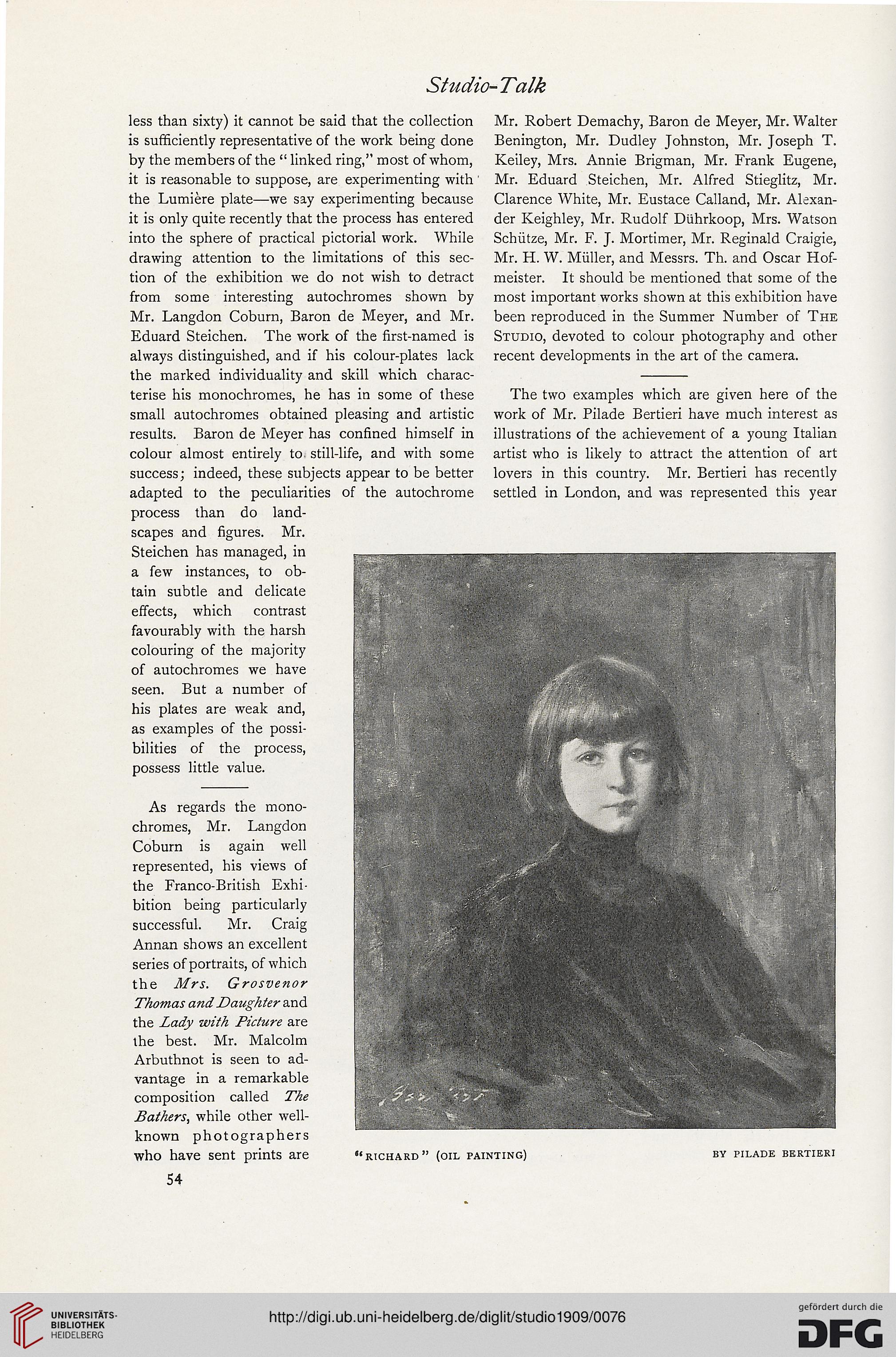Studio-Talk
less than sixty) it cannot be said that the collection
is sufficiently representative of the work being done
by the members of the “ linked ring,” most of whom,
it is reasonable to suppose, are experimenting with '
the Lumière plate—we say experimenting because
it is only quite recently that the process has entered
into the sphere of practical pictorial work. While
drawing attention to the limitations of this sec-
tion of the exhibition we do not wish to detract
from some interesting autochromes shown by
Mr. Langdon Coburn, Baron de Meyer, and Mr.
Eduard Steichen. The work of the first-named is
always distinguished, and if his colour-plates lack
the marked individuality and skill which charac-
terise his monochromes, he has in some of these
small autochromes obtained pleasing and artistic
results. Baron de Meyer has confined himself in
colour almost entirely to still-life, and with some
success; indeed, these subjects appear to be better
adapted to the peculiarities of the autochrome
process than do land-
scapes and figures. Mr.
Steichen has managed, in
a few instances, to ob-
tain subtle and delicate
effects, which contrast
favourably with the harsh
colouring of the majority
of autochromes we have
seen. But a number of
his plates are weak and,
as examples of the possi-
bilities of the process,
possess little value.
As regards the mono-
chromes, Mr. Langdon
Coburn is again well
represented, his views of
the Franco-British Exhi-
bition being particularly
successful. Mr. Craig
Annan shows an excellent
series of portraits, of which
the Mrs. Grosvenor
Thomas and Daughter and
the Lady with Picture are
the best. Mr. Malcolm
Arbuthnot is seen to ad-
vantage in a remarkable
composition called The
Bathers, while other well-
known photographers
who have sent prints are
54
Mr. Robert Demachy, Baron de Meyer, Mr. Walter
Benington, Mr. Dudley Johnston, Mr. Joseph T.
Keiley, Mrs. Annie Brigman, Mr. Frank Eugene,
Mr. Eduard Steichen, Mr. Alfred Stieglitz, Mr.
Clarence White, Mr. Eustace Calland, Mr. Alexan-
der Keighley, Mr. Rudolf Dtihrkoop, Mrs. Watson
Schütze, Mr. F. J. Mortimer, Mr. Reginald Craigie,
Mr. H. W. Müller, and Messrs. Th. and Oscar Hof-
meister. It should be mentioned that some of the
most important works shown at this exhibition have
been reproduced in the Summer Number of The
Studio, devoted to colour photography and other
recent developments in the art of the camera.
The two examples which are given here of the
work of Mr. Pilade Bertieri have much interest as
illustrations of the achievement of a young Italian
artist who is likely to attract the attention of art
lovers in this country. Mr. Bertieri has recently
settled in London, and was represented this year
“richard” (oil painting)
BY PILADE BERTIERI
less than sixty) it cannot be said that the collection
is sufficiently representative of the work being done
by the members of the “ linked ring,” most of whom,
it is reasonable to suppose, are experimenting with '
the Lumière plate—we say experimenting because
it is only quite recently that the process has entered
into the sphere of practical pictorial work. While
drawing attention to the limitations of this sec-
tion of the exhibition we do not wish to detract
from some interesting autochromes shown by
Mr. Langdon Coburn, Baron de Meyer, and Mr.
Eduard Steichen. The work of the first-named is
always distinguished, and if his colour-plates lack
the marked individuality and skill which charac-
terise his monochromes, he has in some of these
small autochromes obtained pleasing and artistic
results. Baron de Meyer has confined himself in
colour almost entirely to still-life, and with some
success; indeed, these subjects appear to be better
adapted to the peculiarities of the autochrome
process than do land-
scapes and figures. Mr.
Steichen has managed, in
a few instances, to ob-
tain subtle and delicate
effects, which contrast
favourably with the harsh
colouring of the majority
of autochromes we have
seen. But a number of
his plates are weak and,
as examples of the possi-
bilities of the process,
possess little value.
As regards the mono-
chromes, Mr. Langdon
Coburn is again well
represented, his views of
the Franco-British Exhi-
bition being particularly
successful. Mr. Craig
Annan shows an excellent
series of portraits, of which
the Mrs. Grosvenor
Thomas and Daughter and
the Lady with Picture are
the best. Mr. Malcolm
Arbuthnot is seen to ad-
vantage in a remarkable
composition called The
Bathers, while other well-
known photographers
who have sent prints are
54
Mr. Robert Demachy, Baron de Meyer, Mr. Walter
Benington, Mr. Dudley Johnston, Mr. Joseph T.
Keiley, Mrs. Annie Brigman, Mr. Frank Eugene,
Mr. Eduard Steichen, Mr. Alfred Stieglitz, Mr.
Clarence White, Mr. Eustace Calland, Mr. Alexan-
der Keighley, Mr. Rudolf Dtihrkoop, Mrs. Watson
Schütze, Mr. F. J. Mortimer, Mr. Reginald Craigie,
Mr. H. W. Müller, and Messrs. Th. and Oscar Hof-
meister. It should be mentioned that some of the
most important works shown at this exhibition have
been reproduced in the Summer Number of The
Studio, devoted to colour photography and other
recent developments in the art of the camera.
The two examples which are given here of the
work of Mr. Pilade Bertieri have much interest as
illustrations of the achievement of a young Italian
artist who is likely to attract the attention of art
lovers in this country. Mr. Bertieri has recently
settled in London, and was represented this year
“richard” (oil painting)
BY PILADE BERTIERI




